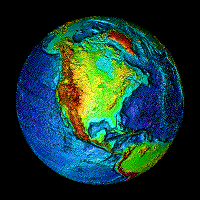Eyjafjallajökull Eruption Intensifying
Fire-Earth can confirm that the eruption at Eyjafjallajökull is intensifying with ash plume rising to a height of about 10km.
The sun turns dark: Eyjafjallajökull through Valahnúk Webcam at 07:30UTC

The eruption at Eyjafjallajökull has almost completely darkened the sky. Click image to enlarge.
Note: The Eyjafjallajökull Hvolsvelli Webcam was not operating properly, as of posting.
How Long Will Eyjafjallajökull Erupt
There is absolutely no reason why the explosive activity at Eyjafjallajökull couldn’t go on for days, weeks even months. Not only Eyjafjallajökull could follow the “Chaitén pattern” and even trigger other, larger volcanoes like Kata to erupt. Indeed, there’s historic precedence for the latter scenario.
Iceland’s Meteorological Office agrees with Fire-Earth assessment.
“The eruption could go on like that for a long time,” geophysicist Bergthora Thorbjarnardottir at the Meteorological Office said.


© Veðurstofa Íslands
Maps of Volcanic Ash in the Atmosphere


Shades of orange represent the volcanic ash in the atmosphere. © Copyright EUMETSAT/Met Office. Click image to enlarge
UKMET: Update to Volcanic Ash Plume — 0851 on Sunday 18 April 2010
“Satellite imagery Sunday morning shows an active volcanic plume spreading ash southwards and southeastwards from southern Iceland. Remnants of earlier plume activity over Europe much less evident now on derived dust imagery. Recent information from the Icelandic Met Office suggests the volcano is currently erupting ash to a height of approximately 4km. Issued at 0850 on Sun 18 Apr 2010.”
Where is the volcanic ash moving?

A diagrammatic illustration of volcanic ash dispersion up to 20,000 ft, issued at 7 pm on 17 April. Advisory charts are issued every six hours, for up to 18 hours ahead, by the Volcanic Ash Advisory Center. Source: UK Met Office.

Volcanic Ash Advisory Graphicsfrom London Met Office. Image may be subject to copyright. Click image to enlarge.
‘Chaos’ as the volcanic ash from Iceland continues to move into Europe’s airspace
About 60,000 flight will have been canceled by Sunday evening (UTC) with an estimated 12 million air travelers stranded since Thursday.
Desperate Airlines ‘Daredevil Management’ May Well End in DISASTER
About 20 countries have closed their airspaces until late Sunday, some into Monday, leaving millions of passengers globally as ash clouds from Eyjafjallajökull eruption linger on in Europe’s airspace.
Dutch and German airlines have reportedly carried out test flights, apparently without any damage to the planes. The most obvious dangers of such recklessness are the facts that the concentration of airborne ash particles is neither uniform, nor constant. High concentration of ash may exists in air pockets that the test flights avoided, or changing wind patterns could increase the concentration of ash in an air route within minutes.
In fact the weather reports say the Icelandic ash concentration in the upper atmosphere may become more concentrated through Wednesday.
Airlines are desperate because, in addition to losing money for each flight canceled, their stock values are taking a nosedive, too. In fact some of the major carriers could lose by as much as 10 percent of their share values by Tuesday.
Why is volcanic ash so dangerous?
Volcanic ash is composed of small tephra, or tiny bits of pulverized glass and rock that are created by volcanic eruptions. The particles are usually accompanied by several gases including sulfur dioxide (SO2), which is mixed with water in the air and converted into droplets of sulfuric acid and other substances that are harmful to the plane. Volcanic ash is potentially deadly to aircraft and their passengers. It poses three types of danger to aircraft by way of:
- Clogging the engine and causing engine failure
- Clogging the fuel and cooling systems
- Melting in the hot parts of the engine, and fusing on engine components thereby causing loss of engine thrust that could lead into a flame out, shutting down the engine
- Breaking the blades and other sensitive components inside the turbine
- Causing physical damage to various parts of the plane including abrasion of engine parts, the airframe, as well as control and steering mechanism
- Reducing visibility
Few Facts about Icelandic Volcanoes
- Iceland is home to about 130 volcanoes, 18 of which have erupted since about 1,000 years ago.
- Eruption from Iceland’s volcanoes have produced more than 30 percent of the total lava output globally, since the 1500s.
- The Laki eruption in 1783-1784 produced he largest volume of lava in the last 500 years.
- An eruption of Eldgjá in 934 CE produced twice as much lava as did Laki.
Explosion at Laki (Lakagigar) Volcanic fissure
A destructive eruption at Laki volcano, which occurred over an 8-month period in 1783–1784, ejected about 14 cubic km (3.4 cu mi) of basalt lava and plumes of poisonous hydrofluoric acid and sulfur-dioxide gas that lead to a famine in Iceland. About a quarter of the population and half of all livestock perished. Dust clouds covered most of Europe and parts of Eurasia and Africa for a year.
For all previous entries and and related links click
See also
Flight disruptions
Serial No 1,589. Starting April 2010, each entry on this blog has a unique serial number. If any of the numbers are missing, it may mean that the corresponding entry has been blocked by Google/the authorities in your country. Please drop us a line if you detect any anomaly/missing number(s).










